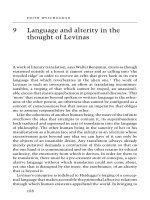Intercultural communication Language and culture relationship
Bạn đang xem bản rút gọn của tài liệu. Xem và tải ngay bản đầy đủ của tài liệu tại đây (1.99 MB, 29 trang )
THE LANGUAGE - CULTURE RELATIONSHIP
Group 2:
Pham Phuc Khanh Minh
Nguyen Tran Hoai Phuong
Nguyen Ngoc Phuong Thanh
Vo Thi Thanh Thu
Do Thi Bach Van
Outline
Overview
Meaning as sign
Meaning as action
Implications in ELT
THE RELATIONSHIP OF
LANGUAGE AND CULTURE
LINGUISTIC RELATIVITY THEORY
•
Different people speak differently because they think differently, and they think
differently because their language offers them differently. (Boas, F.)
•
The structure of the language one habitually uses influences the manner in which
one thinks and behaves. (Sapir, E. & Whorf, L.)
WHORF’S EXAMPLE
EMPTY
Linguistic meaning:
without gasoline
Mental interpretation:
not dangerous
Action:
Smoke or throw cigarette
butts
“Language filters their perception and the way they categorize experience”
(Whorf, L.).
LINGUISTIC RELATIVITY THEORY
Sapir–Whorf hypothesis’s insights:
Language reflects culture and constrains the way people think.
Culture is expressed through the actual use of the language.
•
•
THE RELATIONSHIP BETWEEN LANGUAGE AND CULTURE
Language expresses cultural reality.
- Words express facts, ideas or events that are communicable.
- Words reflect attitudes, beliefs, and points of view.
Language embodies cultural reality.
- The (spoken, written, or visual) medium people choose to communicate
with one another create meanings that understandable to the group they
belong to.
Language symbolizes cultural reality.
- Language is viewed as a symbol of social identity.
COMMUNITIES OF LANGUAGE USERS
•
Discourse communities = common ways in which members of a social group use language to meet
their social needs
•
Members of the same discourse community share common ways of thinking, behaving, and valuing.
E.g. “I like your sweater!”
- “Oh, thank you!” (said Americans)
- “Oh, really? It’s already quite old” (said the French)
Language is not a culture-free code, distinct from the way people think and behave , but it plays a major
role in the perpetuation of culture.
MEANING AS SIGN
Language can mean through what it refers to as an encoded sign
(semantics) and through what it does as an action in context
(pragmatics).
THE LINGUISTIC SIGN
•
•
Humans’ capacity to create signs that mediate between them and their environment
A signifier and a signified
signifier “ROSE”
•
signified
A sign: neither the word nor the object but the relation between the two
Arbitrariness of the linguistic sign
THE NON-ARBITRARY NATURE OF SIGNS
•
For native speakers, linguistic signs are the non-arbitrary, natural reality they
stand for.
THE MEANING OF SIGNS
•
Denotative
Ex: Rose denotes a sweet-smelling flower.
•
Connotative
Ex: Rose connotes love, passion and beauty.
•
Iconic
Ex: “Whoops!”, “Wow!”
CULTURAL ENCODINGS
•
•
Every discourse community encodes their experience differently.
Different signs denote reality by cutting it up differently.
Ex: In Bavarian German, das Bein denotes the whole leg from the hip to the toes.
In English, there are three words hip, leg, foot.
•
Cultural encodings can change over time in the same language.
CULTURAL ENCODINGS
•
The encoding of experience differs in the nature of the cultural associations.
Ex: dusha (Russian) and soul/ mind (English)
•
With the same speech community, signs might have different semantic values for
people from different discourse communities.
Ex: different cultural literacy
SYMBOLS
•
Signs are naturalized and conventionalized.
Ex: In Vietnamese: khoẻ như trâu
In English: strong as a horse
MEANING AS ACTION
MEANING AS ACTION
Meaning is not in words, but in actions.
(Goethe’s Dr. Faust)
Context of
Context of
situation
culture
Understanding
How is pragmatic meaning culturally realized in verbal exchanges?
Structures of expectation
Contextualization cues
The co-operative principle
Pragmatic coherence
Participants’ roles and the coconstruction of culture
Structures of expectation
The expectation of certain behaviors of others
Different in cultures
Contextualization cues
Help speakers clarify or guide listeners' interpretations of what is being said: verbal, paraverbal
& non-verbal signs
E.g. “I need to get in there. Can you open the door?”
Situated inferences
Pragmatic coherence
Created in the minds of speakers and hearers by the inferences they make Relate
speaker to speaker within the larger cultural context of communication
The co-operative principle
The assumption that in conversation, speakers will not say more than is necessary for
the purpose of the exchange.
4 maxims: relevant, clear, understandable & true
Participants’ roles and the co-
Play various social roles
construction of culture
Culture is jointly constructed through language in action
E.g: Mary: Mommy, sock. – dirty
Mommy: Yes, they are all dirty. I know
IMPLICATIONS IN ELT
Tickoo, M. L. 1995. Language and culture in multicultural societies: viewpoints and visions.
SEAMEO. Singapore.
CULTURAL MEANING
Definition of culture
- Be defined as shared knowledge - “what people must know in order to act as they
do, make the things they make and interpret their experience in the distinctive way
they do”
Both our knowledge and use of language are intertwined with cultural meaning
Communicative styles
COMMUNICATIVE STYLES
Conceptual information
Indexical information
Interaction - management
INTERACTION OF CULTURAL MEANING AND COMMUNICATIVE STYLES
Verbal interaction
Conventions of
Speech acts
writing
SPEECH ACT
Definition of speech act:
-
Uttering a string of meaningful sounds:
+ the act of speaking
+ a variety of acts: informing, questioning, ordering,…
-
No true or false in the utterances, they are the means of performing acts which may be felicitous or infelicitous
Challenges in speech act:
-
Interactants do not share the same background knowledge in such situations.
-
People interact culturally different
Miscommunication









